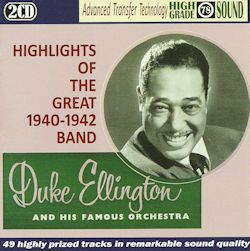CD1
1. Jack The Bear
2. Morning Glory
3. So Far, So Good
4. Ko-Ko
5. Conga Brava
6. Concerto For Cootie
7. Me And You
8. Cotton Tail
9. Never No Lament
10. Dusk
11. Bojangles
12. A Portrait Of Bert Williams
13. Blue Goose
14. Harlem Air Shaft
15. At A Dixie Roadside Diner
16. All Too Soon
17. Rumpus In Richmond
18. My Greatest Mistake
19. Sepia Panorama
20. In A Mellotone
21. The Five O’Clock Whistle
22. Pitter Panther Patter
23. Body And Soul
24. Sophisticated Lady
25. Mr. J.B. Blues
CD2
1. Warm Valley
2. The Flaming Sword
3. Across The Track Blues
4. Chlo-e
5. The Sidewalks Of New York
6. Flamingo
7. Take The “A” Train
8. Jumpin’ Punkins
9. John Hardy’s Wife
10. Blue Serge
11. After All
12. Bakiff
13. Are You Sticking?
14. Just A-Settin’ And A-Rockin’
15. The Giddybug Gallop
16. Chocolate Shake
17. I Got It Bad And That Ain’t Good
18. Clementine
19. Move Over Cuba
20. Five O’Clock Drag
21. Chelsea Bridge
22. Raincheck
23. Perdido
24. The “C” Jam Blues
Duke Ellington – Piano (I/1-25; II/1-19, 21-24)
Billy Strayhorn – Piano (II/20)
Wallace Jones, Cootie Williams – Trumpets (tracks I/1-21; II/1-4)
Wardell Jones – Trumpet (tracks II/5-24)
Ray Nance – Trumpet, violin (tracks II/5-24)
Rex Stewart – Cornet (tracks I/1-21, !!/1-14)
Joe Nanton, Lawrence Brown – Trombone (tracks I/1-21; II/5-24)
Juan Tizol – Valve trombone (tracks I/1-21; II/5-24)
Barney Bigard – Clarinet (tracks I/1-21; II/5-24)
Johnny Hodges – Alto sax, clarinet, soprano sax (tracks I/1-21, II/5-24)
Otto Hardwick – Alto sax, bass sax (tracks I/1-21; II/5-24)
Ben Webster – Tenor sax (tracks I/1-21; II/5-24)
Harry Carney – Baritone sax, clarinet, alto sax (tracks I/1-21; II/5-24)
Fred Guy – Guitar (tracks I/1-21; II/5-24)
Jimmy Blanton – Bass (tracks I/1-25; II/1-20)
Junior Raglin – Bass (tracks II/21-24)
Sonny Greer – Drums (tracks I/1-21, II/1-24)
Ivie Anderson – Vocals (tracks I/3, 7, 15, 21; II/16, 17)
Herb Jefferies – Vocals (track II/6)
Duke Ellington’s ensemble of the early 1940s is often referred to as “The Blanton-Webster Band”, a phrase used in Digby Fairweather’s sleeve-notes. Ten of
the finest tracks from this period are assessed in a reprint of Hector Stewart’s sleeve-notes from a ten-inch LP which singled out his favourites. The
choice of the phrase is understandable, as the band certainly seemed to accrue extra strength when it was joined by bassist Jimmy Blanton and tenorist Ben
Webster. Yet it may be misleading to pinpoint two musicians like this. At various times the band might equally well have been called “The Hodges-Carney
Band” or “The Ellington-Strayhorn Band”.
However, the first track of this double album illustrates the effect that Blanton had on the orchestra when he joined in late 1939 and stayed for a
tragically short two years before his death. In Jack The Bear, Blanton thrust the band along powerfully as well as contributing a solo of
unprecedented impact. Later recordings, like the four duets between Jimmy and the Duke from 1 October 1940, were greeted with acclaim by listeners who had
seldom if ever heard bass playing of such vigour. On Body and Soul he plays the theme on arco bass and then does a long solo, plucking
the bass. The following Sophisticated Lady is also devoted mainly to Blanton, with Ellington accompanying at the piano.
Likewise Ben Webster brought a new authority to the band with his solos on such recordings as Conga Brava, Raincheck and Cotton Tail. This last track shows how Webster had a stimulating effect on drummer Sonny Greer, whose off-beats and general air of elation made
the early-1940s band special. But that period was not the only time when the Ellington unit thrived, and its success was not entirely down to Jimmy and
Ben. One cannot overlook the value of such contributions as that of Barney Bigard’s perky clarinet to Bojangles or the varied tones of Cootie
Williams’ trumpet in his Concerto.
Yes, Jimmy Blanton and Ben Webster made a valuable input to the Duke’s orchestra, but we need not over-estimate their importance. Many other musicians over
the years have had equally significant effects – from Miley to Nance, from Bellson to Gonsalves. As for the selection on these two CDs, it contains most of
the classics you would expect: Ko-Ko, Concerto For Cootie, Sophisticated Lady, Take The “A” Train, etc., etc. There are also many mid-tempo tunes
suitable for dancing: an element of Duke’s repertoire that we should not overlook.
The sound quality on these two discs is variable. The sound has been improved by various devices but it is still not impeccable. There is background hiss
on several tracks and the piano sounds tinny in Warm Valley. But these are classic recordings which established Duke’s band forever in many
people’s minds.
Tony Augarde
www.augardebooks.co.uk
